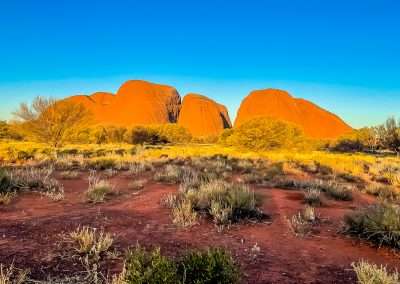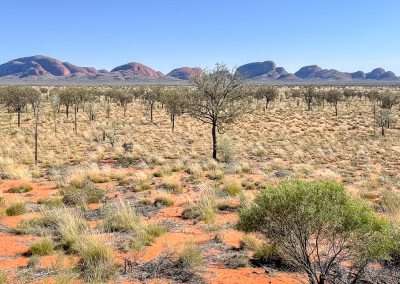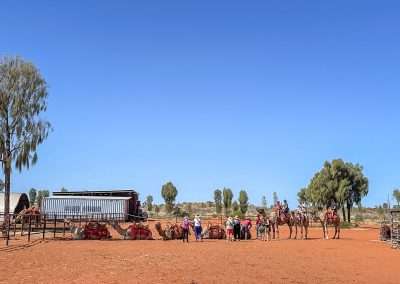Kings Canyon To Uluru – An Awesome Outback Road Trip
Take an awesome road trip from Kings Canyon to Uluru with top recommendations for sights, distances, activities & scenic stops on the journey. If you’re road tripping the heart of the Aussie outback the journey from Kings Canyon to Uluru is a cracker of a trip. We’ve just done it and would like to do it again tomorrow.
You’ll experience the red centre’s iconic landscapes, sweeping plains and maybe even the odd kangaroo hopping across the road. This drive is all about big skies, beautiful emptiness and the chance to get up close and personal with two of Australia’s most jaw dropping natural wonders. So pack your gear, load up the car and let’s hit the road!

Bike Ride Around Uluru Base
Table Of Contents
- The Drive: Kings Canyon To Uluru
- Things To Do On The Drive From Kings Canyon To Uluru (Uluru To Kings Canyon Distance Is About 300km)
- Arriving At Uluru
- Things to Do at Uluru
- Things to Remember
- Driving Tips for the Outback
- Final Thoughts
- Kings Canyon to Uluru Photo Gallery
- FAQs Frequently Asked Questions About Driving From Kings Canyon To Uluru
- How long does it take to drive from Kings Canyon to Uluru?
- Is the road sealed or am I gonna be off-roading?
- Can I stop anywhere along the way?
- Do I need a 4WD to drive from Kings Canyon to Uluru?
- How much fuel do I need?
- Is there phone reception on the drive?
- What’s the scenery like? Will I be bored stiff?
- Is it safe to drive at night?
- Can I camp along the way?
- What’s the best time of year to make the trip?
The Drive: Kings Canyon To Uluru
Kings Canyon to Uluru is about 300 kilometres of classic outback driving. It takes around 3.5 to 4 hours. Total time taken will depend on how many times you stop to soak in the views or snap a few pics of the endless landscape. The road is sealed so it’s an easy drive even for a 2WD but make sure your car is in good nick and you’ve got plenty of water and snacks. There is only one roadhouse / fuel station between Kings Canyon and Uluru and that’s at Curtin Springs about 217 kilometres from Kings Canyon. It’s a good idea to fuel up before you leave Kings Canyon.
Here’s a rough guide to your road trip:
- Starting point: Kings Canyon (Watarrka National Park)
- Distance: About 300 km
- Driving time: Approximately 3.5 to 4 hours
- Road conditions: Sealed (easy for all vehicles)
Once you leave Kings Canyon, follow the Luritja Road out of the national park. It’s a pretty straightforward route with one main turn-off to the Lasseter Highway which takes you straight to Uluru. Not much to navigate so you can focus on the stunning views and avoid getting too tired behind the wheel. I keep saying driving from Kings Canyon to Uluru but in reality you are probably going to stay at Yulara. So I should be really saying the drive from Kings Canyon to Yulara! You’ll see the signs to Yulara so I’m sure you can work out what to do and where to go.
Things To Do On The Drive From Kings Canyon To Uluru (Uluru To Kings Canyon Distance Is About 300km)
As the Uluru to Kings Canyon distance is about 300 kilometres it’s a great idea to break up your trip. The journey between Kings Canyon and Uluru is packed with scenic stops and quirky outback experiences. You don’t have to just sit behind the wheel and zoom by the red dirt—make the most of the drive with these top things to do along the way:
- Check Out Curtin Springs Station
About halfway between Kings Canyon and Uluru you’ll come across Curtin Springs. It’s a working cattle station, but they’ve got a roadhouse, accommodation and even a quirky little pub where you can grab a cold one. It’s a top spot to stretch your legs, fill up the tank and have something to eat. We’ve called in there a couple of times and we reckon it’s great. - Mount Conner Lookout
As you’re driving along the Lasseter Highway you might think you’ve spotted Uluru early but hang on, that’s actually Mount Conner. Also known as “Fool-uru”! This flat-topped mountain looks like Uluru’s cousin and makes for a cracking photo stop. Pull over at the Mount Conner Lookout for a great view and a bit of a leg stretch. If you stop at Mount Conner Lookout make sure you cross the road and walk up the dune. There’s a pretty clearly defined path as lots of people do the little walk. There’s a view over a giant salt lake that you’d never see otherwise! - Enjoy the Vast Outback Views
The wide, open landscapes are part of what makes this road trip so special. You’ll be driving through the desert with endless red dirt stretching out to the horizon. Keep an eye out for wildlife, emus, camels and even wild brumbies have been known to cross the road. And if you’re lucky you might even spot a wedge-tailed eagle soaring above. - Snap a Few Sunset or Sunrise Shots
While you might not time your drive exactly at sunrise or sunset if you’re close make sure you stop and admire the colours. The outback comes alive with shades of red, orange and pink during these times and it’s a photographer’s dream. Keep in mind though that the wildlife is more likely to be on or around the road at sunrise and sunset and definitely after dark so take extra care. - Geocaching
If you’re into geocaching and you have your app open on your phone you’ll find several geocaches along the drive from Kings Canyon to Yulara. The best one we picked up on the other side of the road at Mount Conner Lookout.

Sand Dune Opposite Mt Conner Lookout
Arriving At Uluru
As you get closer to Uluru the big red rock starts to dominate the horizon. And trust me even if you’ve seen a thousand photos nothing prepares you for seeing Uluru in person. It’s like stepping into a postcard and you’ll feel a sense of awe as you approach. The couple of times we’ve been to Uluru we’ve had the awesome Aussie rock song “Solid Rock” by Goanna cued up and ready to play! It makes the words even more meaningful.
Once you’ve settled in it’s time to explore! There’s heaps to do at Uluru, so don’t just rock up and tick it off your list—take your time and enjoy the magic of this special place.
Things to Do at Uluru
Uluru is more than just a giant rock. It’s a place rich in culture, history and natural beauty. Here are the top things you absolutely must do while you’re at Uluru:
- Walk Around the Base of Uluru
Walking around the base of Uluru is one of the best ways to get up close and personal with the rock. The base walk is about 10.6 kilometres, so it’ll take you a couple of hours, but it’s worth every step. You’ll see different sides of Uluru, from ancient rock art to sacred waterholes. Be sure to pack plenty of water and a hat—it gets hot out there! - Ride A Bike Around the Base of Uluru
Riding a bike around the base of Uluru is one of the best ways to get up close and personal with the rock. We hired bikes from Outback Cycling and the bikes were great plus they provided us with helmets. The base walk is about 10.6 kilometres so getting on a pushy made it a lot easier. You’ll see different sides of Uluru, from ancient rock art to sacred waterholes. Be sure to pack plenty of water and a hat as it gets hot out there! - Watch The Sunrise and Sunset Over Uluru
Watching the sun rise and set over Uluru is one of those unforgettable moments. The way the rock changes colour as the light shifts is just magical. There are designated viewing areas for both sunrise and sunset and it’s well worth getting up early or staying out late to see it. - Watch The Sunrise and Sunset Over Kata Tjuta (The Olgas)
Watching the sun rise and set over Kata Tjuta (The Olgas) is pretty bloody awesome. We’ve seen sunsets over both Uluru and Kata Tjuta (The Olgas) and it’s hard to pick a favourite. If you have time to do just one then I’d pick Uluru – but if you can see both then absolutely do it. There are designated viewing areas for both sunrise and sunset and it’s well worth getting up early or staying out late to see it. - Visit the Uluru-Kata Tjuta Cultural Centre
To learn more about Uluru’s cultural significance call in at the Uluru-Kata Tjuta Cultural Centre. You’ll learn about the Anangu people, the traditional owners of the land and their connection to Uluru. It’s a great way to gain insight into the area’s rich Indigenous heritage. They have local art available in a couple of different galleries – we’ve bought more than a few items here! On our recent trip I ummed and ahhed about buying a carved snake and didn’t. It’s still irritating me that I didn’t. - Take a Scenic Helicopter Flight
If you’ve got a bit of extra cash and want to see Uluru from a new perspective hop on a scenic helicopter flight. You’ll get an incredible view of Uluru and the surrounding landscape including Kata Tjuta (The Olgas), the group of domed rock formations nearby. - Explore Kata Tjuta
While Uluru gets most of the attention, Kata Tjuta (also known as the Olgas) is equally stunning and definitely worth a visit. There are a few walking trails around Kata Tjuta including the Valley of the Winds walk which offers breathtaking views of the giant rock formations. We have done both the Valley of The winds and Walpa Gorge walks and I can’t speak highly enough of either of them. The Valley Of The Winds Walk is much more difficult than the Walpa Gorge walk and requires a pretty decent level of fitness. The Walpa Gorge walk is easily completed by a fat old bastard such as myself. - Camel Ride at Sunset
For something a little different, why not hop on a camel for a sunset ride? You’ll ride through the desert, with Uluru in the distance and experience the outback in a truly unique way. Plus, it’s a great story to tell when you get back home! - Stargazing
The outback is one of the best places in the world to see the stars and Uluru is no exception. On a clear night, the sky is absolutely filled with stars and you can even see the Milky Way. You can join a guided stargazing tour, or just lie back and enjoy the view on your own.

Walpa Gorge At Kata Tjuta (The Olgas)
Things to Remember
- National Park Pass: To visit Uluru you’ll need to purchase a National Park Pass. This can be done online or at the entrance to the park.
- Respect the Land: Uluru is a deeply sacred site for the Anangu people so be mindful of their culture and traditions. Climbing Uluru is not permitted and certain areas are off limits so make sure to follow all signs and guidelines.
- Pack Water and Sunscreen: The outback sun is no joke. Make sure you’ve got plenty of water, sunscreen and a good hat to protect yourself from the heat.
Driving Tips for the Outback
- Fuel Up Beforehand: Fuel stations are few and far between in the outback, so make sure to fill up whenever you can. There’s fuel at Kings Canyon, but after that, your next reliable stop is at Curtin Springs or Uluru itself.
- Carry Extra Water: It’s always a good idea to have extra water with you when driving in the outback. It’s easy to underestimate how hot and dry it can get.
- Watch for Wildlife: Especially at dawn and dusk, when animals are more active, keep an eye out for kangaroos, emus and even camels. You don’t want to be that poor bugger who hits a ‘roo in the middle of nowhere!
- Road Conditions: While the road from Kings Canyon to Uluru is sealed, be cautious on the gravel roads that lead to some of the side attractions. If you’re driving a 2WD, make sure you’re comfortable with the conditions.
Final Thoughts
The drive from Kings Canyon to Uluru is one of the most iconic road trips in Australia. It’s a chance to see the true outback, with its wide-open spaces, stunning landscapes and rich cultural history. So load up the car, grab your mates and get ready for an adventure you won’t forget! Uluru and its surrounding area are more than just places to tick off your bucket list – they’re experiences to be savoured. Whether you’re walking around the base of Uluru, exploring Kata Tjuta, or simply soaking in the outback vibes, you’re in for a real treat. Safe travels and remember to keep your eyes peeled for that perfect sunset photo!

Watching The Sunset At Kata Tjuta (The Olgas)
Kings Canyon to Uluru Photo Gallery
FAQs Frequently Asked Questions About Driving From Kings Canyon To Uluru
How long does it take to drive from Kings Canyon to Uluru?
Is the road sealed or am I gonna be off-roading?
Can I stop anywhere along the way?
Do I need a 4WD to drive from Kings Canyon to Uluru?
How much fuel do I need?
Is there phone reception on the drive?
What’s the scenery like? Will I be bored stiff?
Is it safe to drive at night?
Can I camp along the way?
What’s the best time of year to make the trip?












